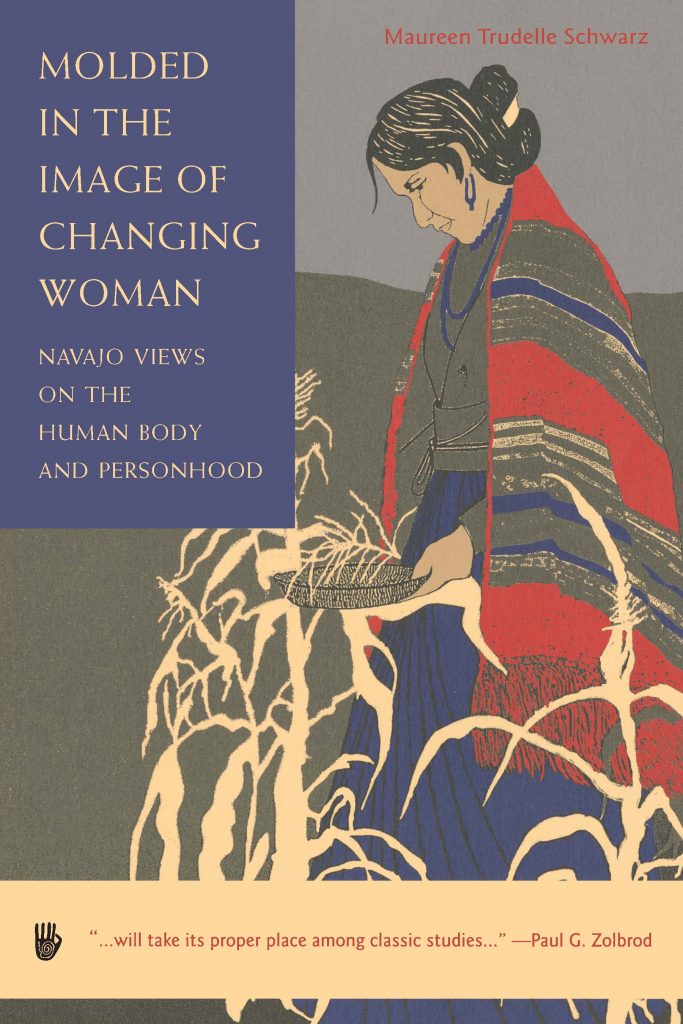Molded in the Image of Changing Woman
Navajo Views on the Human Body and Personhood
Paperback ($35.00), Ebook ($35.00)
Buy
What might result from hearing a particular song, wearing used clothing, or witnessing an accident? Ethnographic accounts of the Navajo refer repeatedly to the influences of events on health and well-being, yet until now no attempt has been made to clarify the Navajo system of rules governing association and effect.
This book focuses on the complex interweaving of the cosmological, social, and bodily realms that Navajo people navigate in an effort alternately to control, contain, or harness the power manifested in various effects. Following the Navajo life-course from conception to puberty, Maureen Trudelle Schwarz explores the complex rules defining who or what can affect what or whom in specific circumstances as a means of determining what these effects tell us about the cultural construction of the human body and personhood for the Navajo.
Schwarz shows how oral history informs Navajo conceptions of the body and personhood, showing how these conceptions are central to an ongoing Navajo identity. She treats the vivid narratives of emergence life-origins as compressed metaphorical accounts, rather than as myth, and is thus able to derive from what individual Navajos say about the past their understandings of personhood in a worldview that is actually a viable philosophical system. Working with Navajo religious practitioners, elders, and professional scholars. Schwarz has gained from her informants an unusually firm grasp of the Navajo highlighted by the foregrounding of Navajo voices through excerpts of interviews. These passages enliven the book and present Schwarz and her Navajo consultants as real, multifaceted human beings within the ethnographic context.
This book focuses on the complex interweaving of the cosmological, social, and bodily realms that Navajo people navigate in an effort alternately to control, contain, or harness the power manifested in various effects. Following the Navajo life-course from conception to puberty, Maureen Trudelle Schwarz explores the complex rules defining who or what can affect what or whom in specific circumstances as a means of determining what these effects tell us about the cultural construction of the human body and personhood for the Navajo.
Schwarz shows how oral history informs Navajo conceptions of the body and personhood, showing how these conceptions are central to an ongoing Navajo identity. She treats the vivid narratives of emergence life-origins as compressed metaphorical accounts, rather than as myth, and is thus able to derive from what individual Navajos say about the past their understandings of personhood in a worldview that is actually a viable philosophical system. Working with Navajo religious practitioners, elders, and professional scholars. Schwarz has gained from her informants an unusually firm grasp of the Navajo highlighted by the foregrounding of Navajo voices through excerpts of interviews. These passages enliven the book and present Schwarz and her Navajo consultants as real, multifaceted human beings within the ethnographic context.
"A remarkable and significant contribution to Navajo studies, the study of culture as practice, and anthropological research on religion, personhood, and the body. . . . A fine and important piece of ethnography." —Carolyn Epple, American Anthropologist
"An impressive study of Navajo values . . . To my knowledge, no other work by an anthropologist represents the intellectual depth of an American Indian tribe in such material terms. . . . The book will reward the careful reader with knowledge necessary to understand what artifacts are saying about history, a world view and a way of life more intricate and profound than baskets and pots on silent display." —Paul Zolbrod, El Palacio
"An impressive study of Navajo values . . . To my knowledge, no other work by an anthropologist represents the intellectual depth of an American Indian tribe in such material terms. . . . The book will reward the careful reader with knowledge necessary to understand what artifacts are saying about history, a world view and a way of life more intricate and profound than baskets and pots on silent display." —Paul Zolbrod, El Palacio
 The University of Arizona Press
The University of Arizona Press

